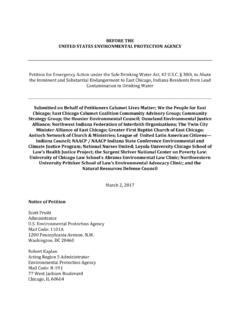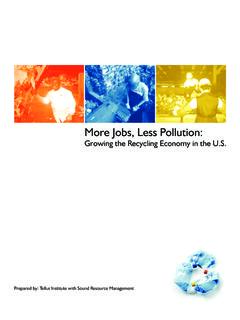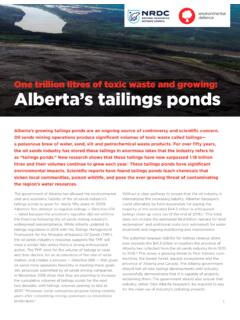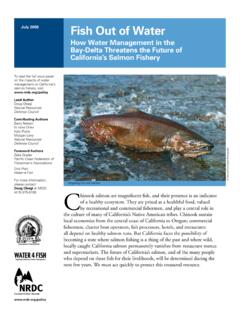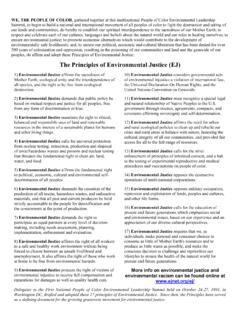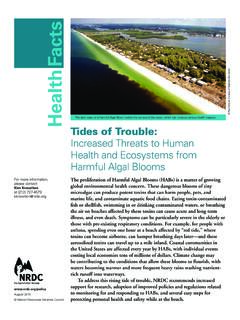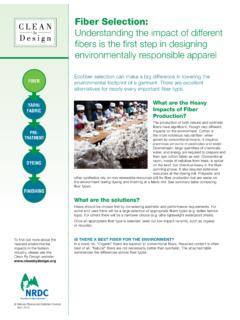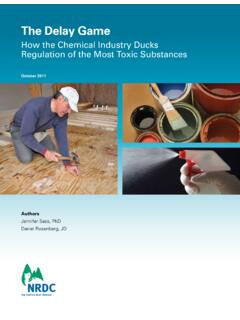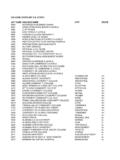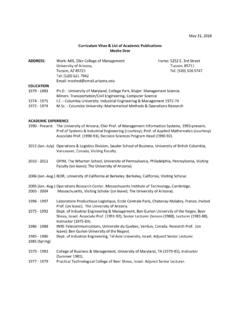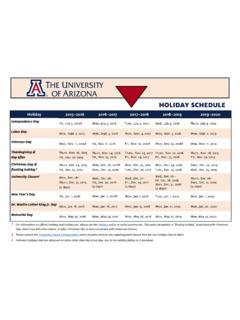Transcription of CASE STUDY: THE UNIVERSITy OF ARIZONA, HOME OF THE …
1 PAGE 57 | Collegiate Game Changers: How Campus Sport is Going Green | The UNIVERSITy of ArizonaTHE WILDCATS GREENING STORY: MOTIVATIONS, CHALLENGES, AND LESSONSIn 2010, the UNIVERSITy of arizona (the UA) built the first UNIVERSITy recreation center in the United States to be awarded LEED Platinum certification. This facility is also the first in the nation to use solar energy for both heating the Olympic-size pool and cooling the building s chiller systems. The UA athletics department boasts on-site solar at the Hillenbrand Aquatic Center and resource-saving artificial football turf, and is awaiting LEED certification of the Lowell-Stevens Football Facility.
2 The UA is successfully integrating sustainability across all sports facilities and operations, reducing both resource use and operational IS THE UA GREENING SPORTS?According to Joe Abraham, director of the UA Office of Sustainability, there is often a financial case for greening sports. One reason the UA is integrating sustainability into sports programs is because it makes business sense, says Abraham. Implementing new technologies and greening programs into our sports facilities helps reduce our energy and water use. Brand enhancement is another reason the UA is advancing sports greening. As the country pivots toward sustainability, going green also enhances the UA s reputation, explains Abraham.
3 For example, the UA was recently listed as one of the Princeton Review s Top Green Schools. This recognition is valuable for recruiting students. The UA is also greening sports to support its students interests in sustainability. By implementing new sustainability projects supported by our student-governed UA Green Fund, the UA increases its visibility as a place where exciting green things are happening, Abraham explains. WHERE DID THE UA START?GREEN BUILDING LEADERSHIP In building a more sustainable campus, start with an institutional commitment to build green buildings, says Peter Dourlein, assistant vice president of UA Planning, Design, and Construction.
4 The UA requires that all new buildings and major renovations achieve a LEED rating of Silver or better. UNIVERSITy standards on how to maintain those buildings ensure that these facilities live up to their full potential. UA Planning Design & Construction maintains these standards with UA Facilities Management and other Business Affairs units. LOCATION: Tucson, ArizonaFOUNDED:1885 TYPE:PublicTOTAL STUDENT POPULATION:38,057 (29,719 undergraduates)STAFF:12,164 PRIMARY ATHLETICS CONFERENCE:Pacific 12 (Pac-12)PRImARy ATHLETICS DIVISION: NCAA Division 1 NUmBER OF VARSITy TEAmS: 20 (12 women s, 8 men s)NUMBER OF SPORTS FACILITIES: 24 (14 athletic, 10 recreational)SUSTAINABILITY OFFICE FOUNDED: 2010 AASHE STARS RATING: Gold, 2012 SPORTS GREENING wORK STARTED: 2007 SPORTS FACILITY LEED CERTIFICATIONS: Student Recreation Center, LEED Platinum Certification for New Construction, 2010.
5 Lowell-Stevens Football Facility, LEED Silver (or greater) Certification for New Construction (pending) case study : THE UNIVERSITy OF arizona , HOME OF THE wILDCATSCAMPUS FACTS one reAson the uA is integrAting sustAinAbility into sports progrAms is becAuse it mAkes business sense, sAys joe AbrAhAm, director of the uA office of UNIVERSITy of arizona | Collegiate Game Changers: How Campus Sport is Going Green | PAGE 58 The first major green building initiative at a UA sports facility, in 2009, was an $ million expansion of the Student Recreation Center. The first place many students interact with when they arrive on campus is the Recreation Center, notes Lynn Zwaagstra, director of UA Campus Recreation.
6 With close to 25,000 students using the Student Recreation Center and almost 835,000 total visits last year, we are pleased to help advance our institutional sustainability goals. The UA s department of Campus Recreation helped lead the design team for the 53,000-square-foot expansion, which doubled the amount of space for cardio-fitness, strength conditioning, and several new activities. Green building was prioritized from the outset of the design process in order to promote student health and wellness, minimize environmental impact, and conserve water, especially important in Tucson s arid Recreation took advantage of on-campus experts in sustainable design, including faculty, students, and operations staff, to improve the green features of the building.
7 For example, students and staff from the UA s College of Agriculture and Life Sciences assisted with the landscaping and water-harvesting aspects of the design. Students, along with faculty from the Department of Soil, water, and Environmental Science, installed passive water harvesting basins to manage rainfall runoff adjacent to the facility. Facilities management identified the efficient irrigation and mechanical systems. UA parking and transportation services dedicated prime parking spaces to low-emission said that the interdepartmental collaboration was unique. Various UA programs, students, faculty, and staff came together to make the LEED certification happen, and we couldn t be more proud.
8 The expansion was originally designed to achieve LEED Silver certification, in accordance with UA construction policy. However, the UNIVERSITy worked with its design firm to achieve LEED Platinum certification without affecting the original project budget, says Dourlein. One notable design feature is the 346-vacuum-tube thermal solar collector that spans the facility s roof and produces almost 2 million kilowatt-hours of solar power each year. The solar energy drives an absorption chilling system that helps cool campus buildings. Heat, a by-product of this process, is captured and used to warm the Recreation Center s 55,000-gallon Olympic-size swimming pool.
9 The thermal solar array provides one-third of the energy needed to heat the unique feature is the water retention basin built under the volleyball courts. This basin stores rainwater collected from the center s roof and allows the water to percolate into the ground, helping to minimize stormwater runoff. Dourlein also praises the UA s extensive outdoor space for helping to minimize the building s footprint. The most sustainable building is the one you never have to build, so making the most of outdoor space and therefore reducing the indoor conditioned space we build is one of the greenest things we can do, he explains.
10 Student use of the recreation center has increased 91 percent since the building opened in January 2010. myles Palmer, a desk assistant at the center, thinks that has something to do with the environmental quality of the new space. The previous interior was really fluorescent, but now the windows bring in natural light that s easy on the eyes, he says. And the old weight room didn t have the open, natural feel that the new one does. The new building uses natural daylight in 99 percent of all commonly occupied spaces and has improved indoor air quality with added LEED Platinum Recreation Center isn t the only UA sports facility that features on-site solar.
